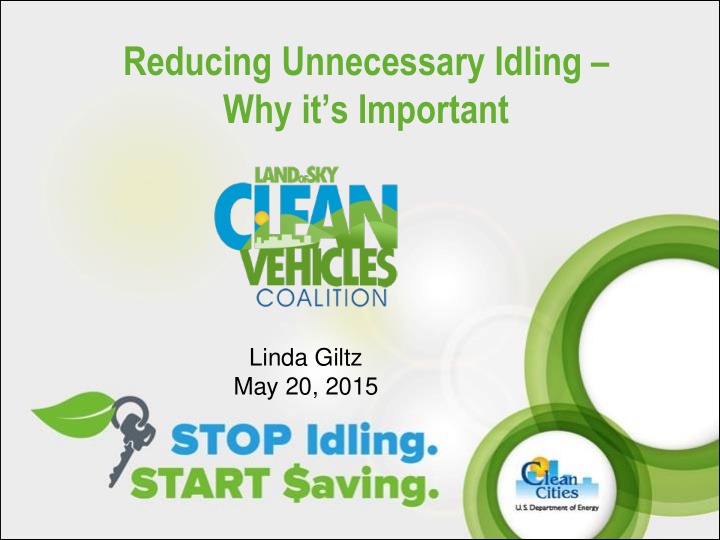



Reducing Unnecessary Idling – Why it’s Important Linda Giltz May 20, 2015
What Is Idling? When a vehicle is running for nonpropulsion purposes, it is idling. Examples: • Trucks or cars idling while in queue • Vehicles waiting to load/unload passengers or goods, including: • Delivery trucks • Shuttle buses • Taxis • Personal vehicles 2
What Types of Vehicles Idle? Light Duty • Passenger vehicles including taxis, police cruisers, and some light trucks Medium Duty • Utility vehicles, delivery trucks, shuttle buses, and ambulances Heavy Duty • Long-haul trucks, tour buses, school buses 3
The Problem • Personal-vehicle idling generates about half of all idling emissions. – 30 million tons of CO 2 annually. – More than 3 billion gallons of fuel at a cost of more than $10 billion each year. 4
Most Idling Is Wasteful Waiting in queue • Delivery trucks, transit buses and motor coaches, shuttle buses, taxis Engine warming • Today’s vehicles warm up faster by being driven than idling Sitting in vehicle • During lunch breaks, to complete paperwork, to make phone calls 5
Idling Reduction Is The Low-Hanging Fruit of Fuel Economy One Easy Habit To Help You “Go Green” 6
Crossover Time: 10 Seconds Idling for more than 10 seconds uses more fuel and results in the production of more CO 2 than does stopping and restarting your engine. Fact sheet from the study available here: http://www.afdc.energy.gov/uploads/public ation/which_is_greener.pdf 7
Why Do Drivers Idle? Habits and Myths “ Doesn’t restarting my engine use more gas than idling?” “Won’t I wear out my starter?” “Isn’t idling good for your engine?” 8
So, What’s the Big Deal about Idling? 1. Idling pollutes 2. Idling threatens health 3. Idling is expensive 9
1. Idling Pollutes • Each gallon of fuel burned produces about 20 pounds of carbon dioxide, a greenhouse gas. Nationally, 27% of greenhouse gas emissions come from • transportation. Pollution from motor vehicles contributes to the formation of • ground-level ozone (smog), which can damage lungs and make conditions like asthma worse. 10
2. Idling threatens health • The most significant health impacts of transportation stem from tailpipe emissions. • Particulate matter irritates the eyes, nose, throat, and lungs, contributing to respiratory and cardiovascular illnesses and even premature death. • Ozone can inflame and damage the airways and aggravate lung diseases such as asthma, emphysema, and chronic bronchitis . 11
2. Idling threatens health – especially for children Vehicle emissions are more concentrated at ground level Children breathe more air per pound of body weight than adults – taking in higher “doses” of pollutants. 12
2. Idling threatens health – for older adults Particle pollution is especially dangerous for older adults – because not only does it affect people with breathing problems, it can also cause heart attacks, strokes and increase hospital visits. Older adults generally have weaker immune systems. Recent studies looking into cognitive impacts of air pollution, especially particulates. E.g., http://blog.oup.com/2015/04/air- pollution-cognitive-function-older-adults/ 13
3. Idling is Expensive $$ If each car in the U.S. idles just 6 minutes per day, nearly 3 billion gallons of fuel are wasted annually, costing drivers more than $10 billion. Engine idling increases vehicle maintenance costs and can shorten vehicle life. 14
3. … and Wasteful 15
And: Idling May Be Illegal cleancities.energy.gov/idlebase 16
What Can You Do? • If you’re likely to be stopped for more Crossover Time: than 10 seconds, consider stopping and 10 Seconds restarting. Waiting to pick up someone • Drive-through transactions (pharmacies, • banks, fast food,) Railroad crossings and bridge lifts • • Use accessory mode. • Warm up your vehicle by starting it and gently accelerating, NOT by idling. 17
Want More Information? Clean Cities – IdleBox Toolkit http://www1.eere.energy.gov/cleancities/toolbox/idlebo x.html NC Division of Air Quality – Idling Info http://www.ncair.org/motor/idle/ Alternative Fuels Data Center: Light-Duty Vehicle Idle Reduction Strategies afdc.energy.gov/conserve/idle_reduction_light.html Land of Sky Clean Vehicles Coalition http://www.cleanvehiclescoalition.org/news.php 18
Questions? Thank You! Linda Giltz, AICP, Community & Environmental Planning Consultant lindagiltz@gmail.com 828-236-2966
Recommend
More recommend